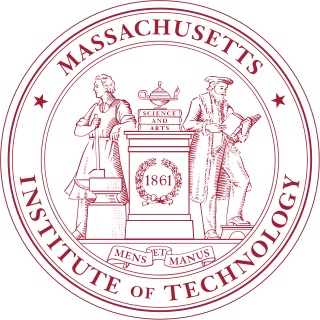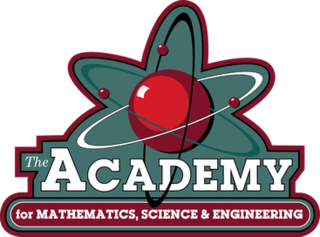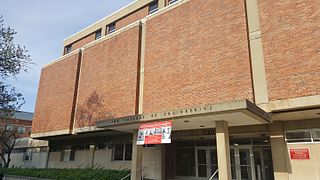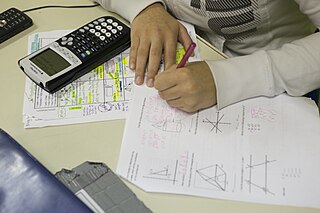
Engineering is the use of scientific principles to design and build machines, structures, and other items, including bridges, tunnels, roads, vehicles, and buildings. The discipline of engineering encompasses a broad range of more specialized fields of engineering, each with a more specific emphasis on particular areas of applied mathematics, applied science, and types of application. See glossary of engineering.

The Massachusetts Institute of Technology (MIT) is a private land-grant research university in Cambridge, Massachusetts. Established in 1861, MIT has played a significant role in the development of many areas of modern technology and science.

Mechatronics engineering also called mechatronics, is an interdisciplinary branch of engineering that focuses on the integration of mechanical, electrical and electronic engineering systems, and also includes a combination of robotics, electronics, computer science, telecommunications, systems, control, and product engineering.

David Orlin Hestenes is a theoretical physicist and science educator. He is best known as chief architect of geometric algebra as a unified language for mathematics and physics, and as founder of Modelling Instruction, a research-based program to reform K–12 Science, Technology, Engineering, and Mathematics (STEM) education.

The Academy for Mathematics, Science, and Engineering (AMSE) is a four-year magnet public high school program intended to prepare students for STEM careers. Housed on the campus of Morris Hills High School in Rockaway, New Jersey, United States, it is a joint endeavor between the Morris County Vocational School District and the Morris Hills Regional District.

The Edison Academy Magnet School is a four-year career academy and college preparatory magnet public high school located on the campus of the Middlesex County College in Edison, in Middlesex County, New Jersey, United States, serving students in ninth through twelfth grades as part of the Middlesex County Magnet Schools. The school serves students from all over Middlesex County who are eligible to apply to their program of choice while in eighth grade.

Housing at the Massachusetts Institute of Technology (MIT) consists of eleven undergraduate dormitories and nine graduate dorms. All undergraduate students are required to live in an MIT residence during their first year of study. Undergraduate dorms are usually divided into suites or floors, and usually have Graduate Resident Assistants (GRA), graduate students living among the undergraduates who help support student morale and social activities. Many MIT undergraduate dorms are known for their distinctive student cultures and traditions.

The John D. O'Bryant School of Mathematics and Science, formerly known as Boston Technical High School is a college preparatory public exam school along with Boston Latin School and Boston Latin Academy. The O’Bryant specializes in science, technology, engineering and mathematics ("STEM") in the city of Boston, Massachusetts, and is named for one of Boston's prominent African-American educators John D. O'Bryant. The school is currently located on 55 Malcolm X Boulevard in the neighborhood of Roxbury, Massachusetts. With a student body of 1,500 7th–12th graders, this school is part of the Boston Public Schools. The school was named a 2010 Blue Ribbon School of Excellence, the US Department of Education's highest award. In 2014 the school was awarded Gold by the US News Best High School Ranking, indicating that it is one of the top public high schools in the country.

The Central Virginia Governor's School for Science and Technology (CVGS) is a regional school in Lynchburg, Virginia directed by Dr. Stephen Smith. Students are chosen from Lynchburg-area county and city schools. Schools participating in the Governor's School include those from Amherst County, Appomattox County, Bedford County, Campbell County, and the City of Lynchburg.
The Career Enrichment Center (CEC), is an Albuquerque Public Schools Magnet High School. Its full name is the Charles R. Spain Career Enrichment Center, named in honor of a former Superintendent of Albuquerque Public Schools. The name means that the curriculum prepares high school students for actual careers in very specific ways. The school provides specialized Science, Technology and Vocational classes for students from all APS High Schools. It also has its own specialized high school and associate degree program. This program is called the Early College Academy, or ECA, and is a cooperation between CEC and Central New Mexico Community College.

The Ohio State University College of Engineering, including the Knowlton School is the academic unit that manages engineering research and education at Ohio State University. The college can trace its origins to 1870 when the Ohio General Assembly chartered the Ohio Agricultural and Mechanical College. In 1878, the institution's name changed to The Ohio State University.

Environmental engineering science (EES) is a multidisciplinary field of engineering science that combines the biological, chemical and physical sciences with the field of engineering. This major traditionally requires the student to take basic engineering classes in fields such as thermodynamics, advanced math, computer modeling and simulation and technical classes in subjects such as statics, mechanics, hydrology, and fluid dynamics. As the student progresses, the upper division elective classes define a specific field of study for the student with a choice in a range of science, technology and engineering related classes.
The SeaPerch is an educational tool and kit that allows elementary, middle, and high-school students to construct a simple, remotely operated underwater vehicle, or Remotely Operated Vehicle (ROV), from polyvinyl chloride (PVC) pipe and other readily made materials. The SeaPerch program is a curriculum designed program that teaches students basic skills in ship and submarine design and encourages students to explore naval architecture and marine and ocean engineering concepts. It was inspired by the 1997 book,Build Your Own Underwater Robot and other Wet Projects, by Harry Bohm and Vickie Jensen. The Massachusetts Institute of Technology Sea Grant (MITSG) College Program created the SeaPerch initiative in 2003, and it is sponsored by the Office of Naval Research, as part of the National Naval Responsibility for Naval Engineering (NNRNE) to find the next generation of Naval Architects, Marine Engineers, Naval Engineers, and Ocean Engineers.

From kindergarten through high school, mathematics education in public schools in the United States has historically varied widely from state to state, and often even varies considerably within individual states. There has been considerable disagreement on the style and contents of mathematics teaching, including the question of whether or not there should be any national standards at all. Moreover, many students take alternatives to the traditional pathways, including accelerated tracks. As of 2023, twenty-seven states require students to pass three math courses before graduation from high school, but seventeen states and the District of Columbia require four.

The Faculty of Engineering is one of six faculties at the University of Waterloo in Waterloo, Ontario, Canada. It has 8,698 undergraduate students, 2176 graduate students, 334 faculty and 52,750 alumni making it the largest engineering school in Canada with external research funding from 195 Canadian and international partners exceeding $86.8 million. Ranked among the top 50 engineering schools in the world, the Faculty of Engineering houses eight academic units and offers 15 bachelor's degree programs in a variety of disciplines.

Aprille J. Ericsson-Jackson is an American aerospace engineer. Ericsson-Jackson is the first African-American woman to receive a Ph.D. in mechanical engineering from Howard University and the first African-American woman to receive a Ph.D. in Engineering at the National Aeronautics and Space Administration (NASA) Goddard Space Flight Center (GSFC).
Bootstrap is based at Brown University (USA), and builds on the research and development done there. Bootstrap curriculum consists of 4 research-based curricular computer science modules for grades 6-12. The 4 modules are Bootstrap:Algebra, Bootstrap:Reactive, Bootstrap:Data Science, and Bootstrap:Physics. Bootstrap materials reinforce core concepts from mainstream subjects like Math, Physics and more, enabling non-CS teachers to adopt the introductory materials while delivering rigorous and engaging computing content drawn from Computer Science classes at universities like Brown, WPI, and Northeastern.

Diversity in computing refers to the representation and inclusion of underrepresented groups, such as women, people of color, individuals with disabilities, and LGBTQ+ individuals, in the field of computing. The computing sector, like other STEM fields, lacks diversity in the United States.

Vaidyeswaran Rajaraman is an Indian engineer, academic and writer, known for his pioneering efforts in the field of Computer Science Education in India. He is credited with the establishment of the first academic program in computer science in India, which he helped initiate at the Indian Institute of Technology, Kanpur in 1965. An elected fellow of all the Indian science academies, he is a recipient of Shanti Swarup Bhatnagar Prize, the highest Indian award in Science and Technology category for young scientists and several other honors including Om Prakash Bhasin Award and Homi Bhabha Prize. The Government of India awarded him the third highest civilian honor of the Padma Bhushan, in 1998, for his contributions to science.
Cardinal Warde is a Professor of Electrical Engineering at Massachusetts Institute of Technology. He works on optoelectronic materials for information processing, communications and holography. Warde is involved with education policy in the Caribbean, acting as a scientific advisor for the Government of Barbados and helping high school students access science education.














